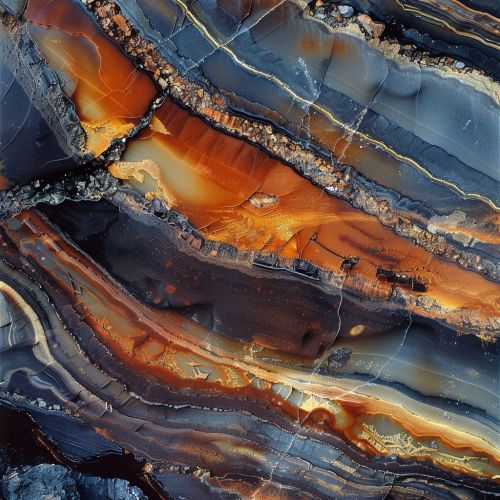Great Oxygenation Event: Difference between revisions
(Created page with "== Introduction == The Great Oxygenation Event (GOE), also known as the Oxygen Catastrophe, Oxygen Crisis, or Great Oxidation, was a pivotal period in Earth's history, occurring approximately 2.4 to 2.0 billion years ago during the Paleoproterozoic era. This event marked a significant increase in Earth's atmospheric oxygen levels, fundamentally altering the planet's environment and biogeochemical cycles. The GOE is considered one of the most transformative events in Ear...") |
No edit summary |
||
| Line 11: | Line 11: | ||
One of the most significant geological indicators of the GOE is the presence of banded iron formations (BIFs). These sedimentary rocks, composed of alternating layers of iron-rich minerals and silica, provide evidence of fluctuating oxygen levels in ancient oceans. The deposition of BIFs is believed to have occurred when dissolved iron in the oceans reacted with free oxygen produced by cyanobacteria, precipitating out as iron oxides. | One of the most significant geological indicators of the GOE is the presence of banded iron formations (BIFs). These sedimentary rocks, composed of alternating layers of iron-rich minerals and silica, provide evidence of fluctuating oxygen levels in ancient oceans. The deposition of BIFs is believed to have occurred when dissolved iron in the oceans reacted with free oxygen produced by cyanobacteria, precipitating out as iron oxides. | ||
[[Image:Detail-91733.jpg|thumb|center|Photograph of a banded iron formation, showing alternating layers of iron-rich minerals and silica.|class=only_on_mobile]] | |||
[[Image:Detail-91734.jpg|thumb|center|Photograph of a banded iron formation, showing alternating layers of iron-rich minerals and silica.|class=only_on_desktop]] | |||
== Biological Implications == | == Biological Implications == | ||
Latest revision as of 22:01, 19 June 2024
Introduction
The Great Oxygenation Event (GOE), also known as the Oxygen Catastrophe, Oxygen Crisis, or Great Oxidation, was a pivotal period in Earth's history, occurring approximately 2.4 to 2.0 billion years ago during the Paleoproterozoic era. This event marked a significant increase in Earth's atmospheric oxygen levels, fundamentally altering the planet's environment and biogeochemical cycles. The GOE is considered one of the most transformative events in Earth's history, leading to the proliferation of aerobic life forms and the eventual rise of complex multicellular organisms.
Geological Context
The GOE took place within the context of the Paleoproterozoic era, a time characterized by significant geological and atmospheric changes. Prior to the GOE, Earth's atmosphere was largely anoxic, composed primarily of nitrogen, carbon dioxide, methane, and other gases. The emergence of oxygenic photosynthesis by cyanobacteria played a crucial role in the accumulation of free oxygen in the atmosphere.
Banded Iron Formations
One of the most significant geological indicators of the GOE is the presence of banded iron formations (BIFs). These sedimentary rocks, composed of alternating layers of iron-rich minerals and silica, provide evidence of fluctuating oxygen levels in ancient oceans. The deposition of BIFs is believed to have occurred when dissolved iron in the oceans reacted with free oxygen produced by cyanobacteria, precipitating out as iron oxides.


Biological Implications
The GOE had profound implications for the evolution of life on Earth. The rise in atmospheric oxygen levels allowed for the development of aerobic respiration, a more efficient metabolic process compared to anaerobic respiration. This shift enabled the evolution of more complex and energy-demanding life forms.
Cyanobacteria
Cyanobacteria, also known as blue-green algae, were the primary drivers of the GOE. These photosynthetic microorganisms utilized sunlight to convert carbon dioxide and water into organic matter and oxygen. The proliferation of cyanobacteria in shallow marine environments led to the gradual accumulation of oxygen in the atmosphere.
Extinction of Anaerobic Organisms
The increase in oxygen levels during the GOE had a detrimental effect on anaerobic organisms, which thrived in anoxic environments. Many of these organisms were unable to survive the oxidative stress caused by the rising oxygen levels, leading to widespread extinctions. This event is sometimes referred to as the "Oxygen Crisis" due to its catastrophic impact on anaerobic life forms.
Atmospheric Changes
The GOE marked a significant transition in Earth's atmospheric composition. Prior to the event, the atmosphere contained less than 0.001% free oxygen. Following the GOE, oxygen levels rose to approximately 1-10% of present atmospheric levels. This increase in oxygen had several key effects on the planet's environment.
Formation of the Ozone Layer
The accumulation of oxygen in the atmosphere led to the formation of the ozone layer, a protective shield that absorbs harmful ultraviolet (UV) radiation from the Sun. The presence of the ozone layer allowed for the colonization of terrestrial environments by shielding organisms from UV radiation.
Changes in Atmospheric Chemistry
The rise in oxygen levels also altered the chemical composition of the atmosphere. Methane, a potent greenhouse gas, reacted with oxygen to form carbon dioxide and water, leading to a decrease in atmospheric methane concentrations. This reduction in methane levels may have contributed to the Huronian glaciation, a global ice age that occurred around the same time as the GOE.
Geochemical Evidence
Geochemical evidence for the GOE comes from various sources, including isotopic analyses of sulfur and carbon. These analyses provide insights into the redox state of the atmosphere and oceans during the Paleoproterozoic era.
Sulfur Isotopes
The study of sulfur isotopes, particularly the ratios of sulfur-32 and sulfur-34, has provided valuable information about the GOE. Prior to the event, sulfur isotopes show evidence of mass-independent fractionation (MIF), a process that occurs in an anoxic atmosphere. The disappearance of MIF signals in sulfur isotopes around 2.4 billion years ago indicates the onset of significant atmospheric oxygenation.
Carbon Isotopes
Carbon isotope ratios, specifically the ratios of carbon-12 and carbon-13, also provide evidence for the GOE. The isotopic composition of organic carbon and carbonate minerals reflects changes in the global carbon cycle and the levels of atmospheric oxygen. An increase in the burial of organic carbon during the GOE suggests enhanced primary productivity and oxygen production by photosynthetic organisms.
Environmental Impact
The GOE had far-reaching environmental impacts, influencing the Earth's climate, ocean chemistry, and the distribution of life.
Climate Change
The reduction in atmospheric methane levels due to the GOE likely contributed to the Huronian glaciation, one of the most severe ice ages in Earth's history. The decrease in greenhouse gases led to global cooling and the expansion of ice sheets, which had significant effects on the planet's climate and ecosystems.
Ocean Chemistry
The increase in atmospheric oxygen levels also affected ocean chemistry. The oxidation of dissolved iron in the oceans led to the precipitation of iron oxides, forming banded iron formations. Additionally, the rise in oxygen levels facilitated the development of more complex marine ecosystems, as aerobic respiration became more prevalent.
Evolutionary Significance
The GOE played a crucial role in the evolution of life on Earth, paving the way for the emergence of complex multicellular organisms and the eventual rise of animals.
Eukaryotic Evolution
The increase in atmospheric oxygen levels created an environment conducive to the evolution of eukaryotic cells, which possess membrane-bound organelles and a nucleus. Aerobic respiration, which is more efficient than anaerobic processes, provided eukaryotic cells with the energy needed to support more complex structures and functions.
Multicellularity
The rise in oxygen levels also facilitated the evolution of multicellularity. Higher oxygen concentrations allowed for the development of larger and more complex organisms, as cells could obtain sufficient energy to support multicellular structures. This transition laid the foundation for the diversification of life forms and the eventual emergence of animals.
Conclusion
The Great Oxygenation Event was a transformative period in Earth's history, marking the transition from an anoxic to an oxygen-rich atmosphere. Driven by the proliferation of cyanobacteria and their oxygenic photosynthesis, the GOE had profound implications for the planet's environment, climate, and the evolution of life. The increase in atmospheric oxygen levels enabled the development of aerobic respiration, the formation of the ozone layer, and the rise of complex multicellular organisms. The GOE remains a key area of research in understanding the interplay between biological and geological processes in shaping Earth's history.
